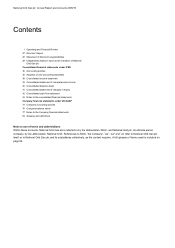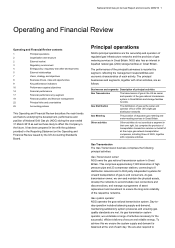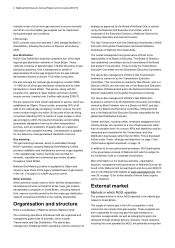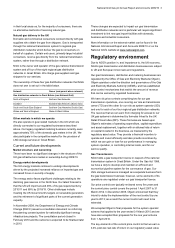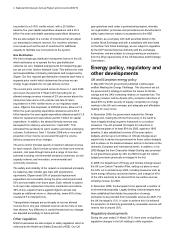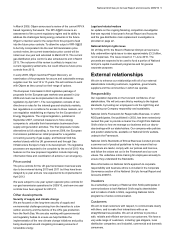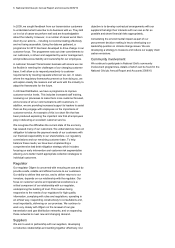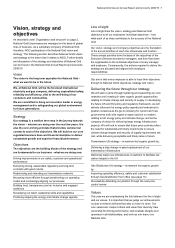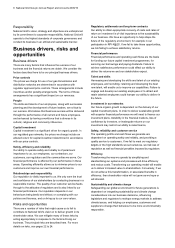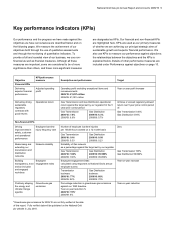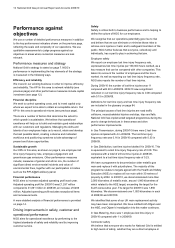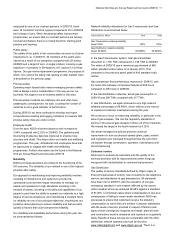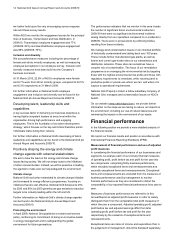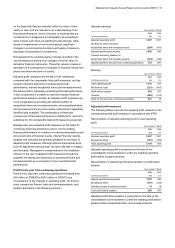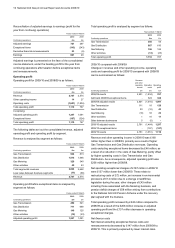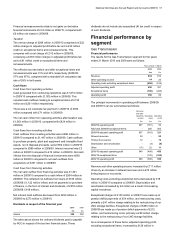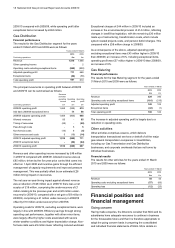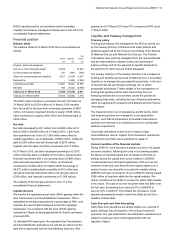National Grid 2010 Annual Report Download - page 12
Download and view the complete annual report
Please find page 12 of the 2010 National Grid annual report below. You can navigate through the pages in the report by either clicking on the pages listed below, or by using the keyword search tool below to find specific information within the annual report.10 National Grid Gas plc Annual Report and Accounts 2009/10
Performance against
objectives
We use a number of detailed performance measures in addition
to the key performance indicators shown on the previous page,
reflecting the scale and complexity of our operations. We use
qualitative assessments to judge progress against our
objectives in areas where numerical measures are less
relevant.
Performance measures and strategy
National Grid’s strategy is stated on page 7. NGG’s
performance in implementing the key elements of the strategy
is measured in the following ways.
Efficiency and reliability
We invest in our existing business in order to improve efficiency
and reliability. The KPI in this area is network reliability (see
previous page) and other performance measures include capital
investment (see page 12).
Financial discipline
We seek to control operating costs, and to invest capital only
where we expect to be able to obtain an acceptable return. Our
KPI in this area is operational returns (see previous page).
There are a number of factors that determine the extent to
which growth is sustainable. We believe that operational
excellence will help us to build and maintain good relationships
with our customers and regulators. Managing the skills and
talents of our employees helps us to recruit, retain and develop
the best possible talent, creating a diverse and motivated
workforce and positioning ourselves to take advantage of
present and future opportunities.
Sustainable growth
Our KPIs in this area, as shown on page 9, are employee lost
time injury frequency rate, employee engagement and
greenhouse gas emissions. Other performance measures
include; measures of gender and ethnic mix, the number of
significant direct environmental incidents and value of
environmental fines, together with our participation in bodies
such as the RPI-X@20 advisory panel.
Financial performance
NGG aims to increase adjusted operating profit each year.
Adjusted operating profit for 2009/10 was £1,297 million
compared to £1,091 million in 2008/09, an increase of £206
million. Adjusted operating profit excludes exceptional items
and remeasurements.
A more detailed analysis of financial performance is provided
on page 14.
Driving improvements in safety, customer and
operational performance
NGG aims for operational excellence by performing to the
highest standards of safety and reliability and by improving
customer service.
Safety
Safety is critical both to business performance and to helping to
define the culture of NGG for our employees.
We recognise that our operations potentially give rise to risk
and believe that we can eliminate or minimise those risks to
achieve zero injuries or harm and to safeguard members of the
public. NGG further believes that everyone, collectively and
individually, has a part to play in achieving that aim.
Employee safety
We report our employee lost time injury frequency rate,
expressed as lost time injuries per 100,000 hours worked, as a
key measure that can be compared with other companies. This
takes into account the number of employees and the hours
worked. As well as reporting our lost time injury frequency rate,
NGG also reports the number of lost time injuries.
During 2009/10 the number of lost time injuries was 11
compared with 28 in 2008/09. 2009/10 saw a significant
reduction in our lost time injury frequency rate to 0.08 compared
with 0.15 in 2008/09.
Definitions for lost time injury and lost time injury frequency rate
are included in the glossary on page 84.
The principal causes of lost time injuries are road traffic
collisions, musculoskeletal injuries and slips, trips and falls.
National Grid has implemented targeted programmes during the
year to change behaviours in these areas and drive
performance improvements.
In Gas Transmission, during 2009/10 there were 2 lost time
injuries compared with 4 in 2008/09. The lost time injury
frequency rate was 0.16 in 2009/10 compared with 0.33 in
2008/09.
In Gas Distribution, lost time injuries totalled 9 in 2009/10. This
is equivalent to a lost time injury frequency rate of 0.08. This
compares with a total of 24 lost time injuries in 2008/09,
equivalent to a lost time injury frequency rate of 0.23.
We have a programme to decommission older metallic gas
main and replace it with polyethylene. The majority of this
programme relates to targets agreed with the Health and Safety
Executive (HSE), to replace all iron main within 30 metres of
property by 2032. In 2009/10, we decommissioned more than
2,000 kilometres of metallic main, around 1,940 kilometres of
which related to the HSE target, exceeding the target for the
fourth consecutive year. The target for 2009/10 was 1,856
kilometres. We decommissioned over 1,850 kilometres in each
of 2008/09 and 2007/08.
We identified that some of our UK main replacement activity
may have been misreported. We have notified both Ofgem and
the HSE, and Ofgem’s investigation into this matter continues.
In Gas Metering, there was 1 employee lost time injury in
2009/10 compared with 1 in 2008/09.
Contractor safety
We believe that everyone who works for National Grid is entitled
to high levels of safety, whether they are a direct employee or


